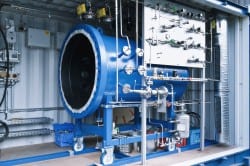A Power-to-Liquids (PtL) demonstration rig which is the first of its kind in the world was officially inaugurated on 14 November by Dresden-based sunfire GmbH. The ceremony was attended by German Federal Minister of Education and Research Johanna Wanka, Board Member Pieter Koolen of venture capitalist Bilfinger (in which Total and EDF participate) as well as a number of other high-ranking representatives from the worlds of politics, industry and research.
The new rig uses sunfire’s PtL technology to transform water and CO2 to high-purity synthetic fuels (petrol, diesel, kerosene) with the aid of renewable electricity. So-called PtL fuels – also known as “e-fuels” – can be used in pure form or as an admixture in combination with conventional fuels, and are recognized as an environmentally friendly, resource-saving alternative which contributes to the fulfilment of greenhouse gas quotas.
 High-temperature steam electrolysis
High-temperature steam electrolysis
The PtL technology is built around the solid oxide electrolysis cells (SOECs) developed by the cleantech firm as part of the eponymous BMBF research project SUNFIRE. Step 1 of the PtL process sees the SOECs used to convert electrical energy to chemical energy. Hydrogen is generated using steam rather than liquid water.
Step 2 – the reverse water-gas shift reaction – is again innovative, and involves the use of the hydrogen (H2) yielded by the steam electrolysis step to reduce carbon dioxide (CO2) to carbon monoxide (CO) for the third and final step: Fischer-Tropsch Synthesis. This step sees the carbon monoxide and additional hydrogen (in the form of renewable synthesis gas) converted to petrol, diesel, kerosene and other base products for the chemicals industry (e.g. waxes). The feeding of the heat released during synthesis back into the process ensures a high degree of system efficiency (70 per cent).
Proof of technical feasibility at industrial scale
The cost of building the PtL demonstration rig was within the seven-digit range, with development costs also incurred at the various consortium members. Half of the overall sum invested corresponds with the public funding received from the Federal Ministry of Education and Research. The rig’s capacity for CO2recycling stands at 3.2 tonnes per day, and once brought into commission it will produce up to a barrel of fuel per day. Commercialization is dependent on further technological development and regulatory factors and scheduled for 2016.
“The sunfire process reduces CO2 emissions and reduces our dependency on oil”, said Federal Minister Johanna Wanka at the inauguration. “It therefore represents an opportunity to protect our climate, save resources and at the same time promote a new technology which promises to deliver economic growth. Over and above that, one huge benefit of PtL fuels is that existing infrastructure such as filling stations, pipelines and motors can continue to be used without modification. This paves the way for sustainable mobility based on renewable energies.”
“This rig enables us to prove technical feasibility on an industrial scale”, commented sunfire CTO Christian von Olshausen. “It is now a matter of regulatory factors falling into place in a way which gives investors a sufficient level of planning reliability. Once that has occurred it will be possible to commence the step-by-step substitution of fossil fuels. If we want to achieve fuel autonomy in the long term, we need to get started today.”
Dr. Karl Ludwig Kley, Managing Director of Bilfinger Venture Capital said: “In the case of sunfire – a start-up in an unconventional industrial sector – it is interesting to note that the technology moves in tandem with the market. As a strategic investor, Bilfinger is able to offer not only technical know-how which feeds into the planning and construction of industrial facilities, but also access to potential customers. In particular, a cooperation has been set up between Bilfinger EMS and sunfire. Both partners have already begun to jointly bring PtL technology to the market.”
Source: Energy Post. Reproduced with permission.









